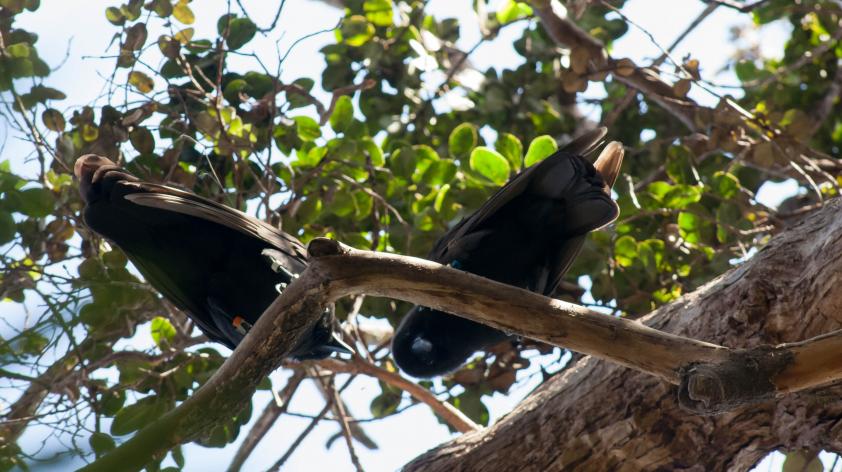
A highly anticipated meeting of one of the world’s rarest birds
This fall we welcomed a new group of juvenile ‘alalā into the dense forests of the Big Island of Hawai’i. Much about this release felt very similar to last year’s.
After leaving the aviary, the birds immediately began exploring their new forest home. Their sounds quickly filled the canopy, as they established the location of their group mates. They began inspecting old tree branches looking for insects nestled among the moss. We recognized the clumsy young birds as they scrambled between the tangled branches, navigating their way back to the supplemental feeding stations.
Yet, this time we knew something was different. Unbeknownst to the new group, this time there were other ‘alalā in the forest. We knew it would only be a matter of time before these birds encountered the group that was released in 2017 from an aviary nearly a mile away.
But there were a lot of unanswered questions about this highly anticipated meeting. When would it happen? How would they react to each other? Older birds can sometimes be aggressive and territorial, but the exact age when this begins depends on the bird and the circumstance.
To help predict the likelihood and outcome of this meeting, we looked back at the last year. We have tracked the daily movements of the older cohort ever since their release in the fall of 2017. These birds have ranged almost two miles from the aviary, and have visited the very kīpuka (forest patch) where the new cohort was released. We’ve compiled thousands of foraging and social observations, which paint a picture of a complex social network with early indicators of pairing behavior. Some birds or pairs tend to roam longer distances in the forest from their release site, while others stay closer to “home”.
Despite these patterns, no bird or pair appears to have set up a territory. Their movements are still very flexible and they explore different parts of the forest on a daily basis. We hoped their lack of territoriality would lessen the likelihood of aggression between the cohorts, but only time would tell.
A few weeks after the recent release I walked down to the aviary for our afternoon survival check on the new birds. As I approached the release site, I saw a group of ‘alalā standing on top of the aviary in a rough circle. With binoculars in hand, I began marking down the color leg bands I could see.
Half way through, I paused.
Only when I approached closer did I realize that Ho’oikaika and Lili’uwelo, two of the most exploratory birds from last year’s cohort, had showed up. They stood tall, yet cautious, as they eyed the four new birds. There was an air of politeness about it all. No scuffles, no sounds, just measuring each other up. From our observations over the past year, I knew the two arrivals were our most closely bonded pair that rarely is aggressive towards others.
It was hard to imagine what the birds were thinking. The four young birds had not seen an ‘alalā outside of their group for over a year. The two new arrivals from the 2017 site have never encountered young ‘alalā in all of their forest ventures.
After standing staring at each other for several minutes, the two birds slowly walked to the edge of the aviary roof, and hopped down onto one of the feeding stations.
Before I knew it, they had silently slipped back into the forest and their meeting was over.
Since then we’ve seen all birds from the 2017 cohort mingle with the newly released birds. They’ve been sorting out their social hierarchy, and learning to interact with each other, all without signs of aggression around food. Their social dynamics will continue to change, but we will be ready to monitor them and respond if needed. While the ‘alalā continue to thrive in the lush forest, we look forward to many more meetings to come.













